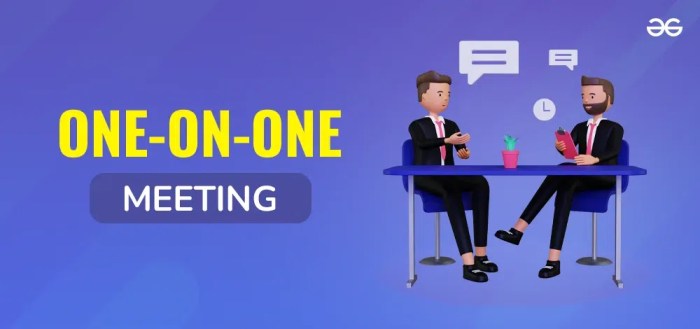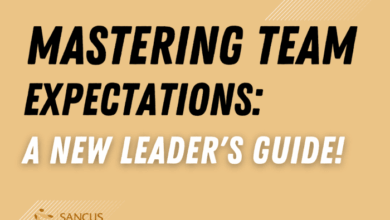
Purpose of one on one meetings are crucial for effective communication and achieving specific goals. This comprehensive guide delves into the intricacies of these meetings, exploring their definition, objectives, preparation, structure, and post-meeting actions. We’ll cover everything from performance reviews and mentorship to conflict resolution and problem-solving.
One-on-one meetings offer a unique opportunity for in-depth discussions and focused collaboration. They are more than just check-ins; they are dynamic tools for professional growth, addressing individual needs, and fostering a strong working relationship. Understanding the purpose of one-on-one meetings is key to leveraging their potential for both individual and team success.
Defining the One-on-One Meeting

A one-on-one meeting is a crucial component of effective professional communication. It provides a dedicated space for focused discussion, tailored feedback, and personal development. These meetings foster a stronger connection between individuals and improve overall team performance. Beyond the basic exchange of information, one-on-one meetings offer a dynamic platform for problem-solving, strategic planning, and building trust.One-on-one meetings stand apart from other types of meetings due to their intimate nature and focused purpose.
They are not intended for group brainstorming or project updates, but rather for individual coaching, performance reviews, or personal goal setting. Their singular focus facilitates deeper understanding and more meaningful interaction than broader group meetings.
Key Characteristics of One-on-One Meetings
One-on-one meetings are distinguished by their direct, personalized approach. They are typically characterized by a confidential and private setting, enabling open communication and candid feedback. The agenda is often collaboratively created, reflecting the specific needs and objectives of both participants. This focused, individualized approach distinguishes them significantly from group meetings, where discussions are often broader and less personalized.
Purposes of One-on-One Meetings
One-on-one meetings serve a variety of crucial purposes. They can be used for performance reviews, providing constructive feedback and guidance to employees. Goal setting and strategic planning are also key aspects, allowing individuals to align their efforts with company objectives. Coaching and mentoring are other vital functions, providing support and guidance to enhance skills and knowledge. Problem-solving and conflict resolution can also benefit from the dedicated space and focused discussion of a one-on-one meeting.
Comparison of One-on-One and Group Meetings
| Characteristic | One-on-One Meeting | Group Meeting |
|---|---|---|
| Objective | Individual performance review, goal setting, feedback, problem-solving, conflict resolution, and mentoring. | Project updates, brainstorming, strategy development, team alignment, and information sharing. |
| Focus | Specific needs and concerns of the individual. | Collective needs and concerns of the group. |
| Outcome | Personalized action plans, enhanced individual performance, and stronger individual-manager relationships. | Shared understanding, project progress updates, and collective decisions. |
| Time Commitment | Typically shorter, dedicated time slots. | Longer duration to accommodate multiple participants and topics. |
| Atmosphere | Confidential and private. | Collaborative and open. |
Objectives of the Meeting
One-on-one meetings are crucial for fostering strong professional relationships and driving individual and team success. They provide a dedicated space for open communication, addressing concerns, and aligning on goals. Effective meetings are characterized by a clear understanding of shared objectives and a commitment to productive dialogue.The core objective of these meetings is to facilitate meaningful conversations that lead to tangible outcomes.
This encompasses everything from addressing performance concerns to exploring career development opportunities, ensuring team alignment, and enhancing overall communication.
Common Objectives
One-on-one meetings are driven by a variety of common objectives. These often include performance reviews, providing constructive feedback, identifying and addressing potential roadblocks, and fostering open communication channels. These objectives are essential for maintaining a healthy work environment and promoting professional growth.
One-on-one meetings are crucial for clarifying goals and fostering understanding. A great example of revisiting a character’s past is the recent Tomb Raider refresh, showing Lara Croft before she became the tough, experienced adventurer. This revisiting helps us see the journey and purpose behind a character’s growth, mirroring the benefits of a productive one-on-one meeting where individuals can explore the purpose and direction of their work, like this Tomb Raider refresh highlights the value of examining origins and past experiences to better understand the present.
Ultimately, these meetings help individuals align their personal and professional goals.
- Performance Review and Feedback: Regular performance reviews are critical for identifying strengths and areas for improvement. Constructive feedback, provided in a supportive and actionable manner, empowers employees to refine their skills and enhance their performance.
- Problem Solving and Roadblocks: These meetings can be valuable in identifying and addressing issues that may be hindering productivity or creating obstacles for an individual or the team. Openly discussing and brainstorming solutions ensures efficient problem-solving and improved workflow.
- Career Development and Goal Setting: One-on-one meetings are vital for discussing career aspirations and aligning individual goals with company objectives. Exploring opportunities for professional growth and outlining clear steps to achieve career goals fosters a sense of purpose and engagement.
- Team Alignment and Communication: Understanding and addressing team dynamics is crucial. These meetings allow for clarification of roles, responsibilities, and expectations, leading to a more cohesive and efficient team.
Effective Communication Techniques
Effective communication is paramount to achieving the objectives of one-on-one meetings. Active listening, clear articulation of thoughts, and respectful dialogue create a safe space for open exchange.
- Active Listening: Active listening involves not just hearing but truly understanding the speaker’s message. This includes paying attention to verbal and nonverbal cues, asking clarifying questions, and reflecting back the speaker’s thoughts to ensure mutual understanding.
- Clear Articulation: Clearly expressing your thoughts and concerns is equally important. Using specific examples, quantifiable data, and avoiding ambiguity ensures that the message is received as intended.
- Open Dialogue and Respect: Maintaining a respectful and open dialogue is essential. Creating a safe space where both parties feel comfortable sharing their perspectives is critical to the success of the meeting.
Situations Requiring One-on-One Meetings
One-on-one meetings are essential in a variety of situations. These meetings can be preventative or reactive, addressing issues before they escalate or offering support during challenging times.
- Performance Issues: Addressing performance concerns promptly and privately is crucial. One-on-one meetings allow for a focused discussion of the issue, identification of potential root causes, and development of solutions together.
- Conflict Resolution: One-on-one meetings can facilitate conflict resolution by providing a platform for both parties to express their concerns and perspectives. A structured approach to conflict resolution, using active listening and clear communication, can help resolve disagreements and restore harmony.
- Career Guidance: Career counseling and guidance are critical for employees at all stages of their careers. One-on-one meetings provide a valuable opportunity to explore career options, identify professional development needs, and Artikel a clear path forward.
Documentation of Objectives, Purpose of one on one meeting
Proper documentation ensures that the discussions and agreements made during one-on-one meetings are effectively tracked and acted upon. This allows for accountability and prevents misunderstandings.
- Meeting Minutes: Creating detailed meeting minutes, including key discussions, agreements, and action items, is crucial. These minutes should be shared with all parties involved and serve as a reference for future actions and follow-ups.
- Action Items and Deadlines: Clearly defining action items and assigning deadlines ensures accountability and promotes timely completion of tasks. A shared understanding of responsibilities and timelines is essential for meeting objectives effectively.
Meeting Preparation
Effective one-on-one meetings require meticulous preparation. This stage is crucial for ensuring the meeting achieves its objectives and is a productive use of everyone’s time. A well-structured approach, encompassing a clear agenda and necessary materials, significantly enhances the meeting’s effectiveness.A proactive approach to preparation helps streamline the meeting process. This includes understanding the meeting’s purpose, defining its objectives, and anticipating potential discussion points.
By taking these steps, you set the stage for a successful exchange of ideas and a productive outcome.
Checklist for Successful One-on-One Meetings
Thorough preparation is the cornerstone of a successful one-on-one meeting. A well-crafted checklist ensures that you cover all the essential aspects before the meeting.
- Review meeting objectives and goals. Confirm that the meeting’s purpose aligns with the pre-defined objectives.
- Identify key discussion points and potential challenges. Anticipating possible roadblocks or areas of contention allows for proactive solutions during the meeting.
- Gather necessary materials and documents. This includes reports, data, or any other relevant information that participants may need during the meeting.
- Confirm the meeting time and location with all participants. Ensuring everyone is aware and prepared to attend on time avoids delays and wasted time.
- Send out a concise agenda. Providing a clear agenda helps participants prepare and know what to expect during the meeting.
- Prepare questions in advance. A list of prepared questions allows you to focus on the main points of discussion, ensuring a comprehensive understanding of the subject matter.
Agenda Setting for Productive One-on-One Meetings
A well-structured agenda is essential for a productive one-on-one meeting. It provides a roadmap for the discussion, ensuring that all key topics are addressed.
- Define the meeting’s purpose and objectives. This ensures the meeting stays focused on achieving its goals.
- Artikel key discussion points. Identify the topics that need to be addressed during the meeting. The agenda should be concise, clearly defining the areas of focus.
- Allocate time slots for each agenda item. Assigning specific time slots to each item helps keep the meeting on track and within the allocated timeframe.
- Establish clear roles and responsibilities for each participant. Determining who will contribute to each topic ensures effective participation and minimizes potential confusion.
- Incorporate follow-up actions and deadlines. Establishing clear next steps and deadlines helps ensure that agreed-upon actions are implemented.
Effective Meeting Agendas for Different Purposes
The structure of an agenda can vary depending on the purpose of the meeting.
| Meeting Purpose | Example Agenda Structure |
|---|---|
| Performance Review |
|
| Project Update |
|
| Problem-solving |
|
Preparing Materials for One-on-One Meetings
Preparing relevant materials enhances the meeting’s effectiveness. The structure should be organized and accessible to all participants.
- Organize materials into a logical format. This can include a presentation deck, reports, or documents that will be referenced during the meeting.
- Ensure materials are easily accessible. Use a digital platform, or have printed copies available for easy reference.
- Provide a clear Artikel of the information to be discussed. A well-structured Artikel helps keep the discussion focused and on track.
- Review and revise the materials before the meeting to ensure accuracy and clarity.
Meeting Structure and Conduct: Purpose Of One On One Meeting
One-on-one meetings are crucial for fostering open communication and achieving individual and team goals. A well-structured and conducted meeting ensures that both parties feel heard and that the desired outcomes are effectively addressed. A clear understanding of the meeting structure and conduct empowers both the manager and the employee to contribute meaningfully.A productive one-on-one meeting goes beyond a simple check-in.
It’s a dynamic exchange of ideas, feedback, and support. The structure should facilitate a natural flow of conversation, allowing both parties to share their perspectives and insights in a comfortable and supportive environment.
Typical Meeting Structure
A typical one-on-one meeting typically follows a structured format, although flexibility is essential. This structure allows for a focused and productive discussion. The meeting should not feel rigid; it should feel natural.
- Opening (5-10 minutes): This stage sets the tone for the entire meeting. It involves acknowledging the purpose of the meeting, reviewing the agenda, and establishing a comfortable environment. The purpose is to smoothly transition into the main discussion. For example, if the agenda includes reviewing performance goals, the opening can set the context for a productive discussion on progress and challenges.
- Discussion of Goals and Progress (20-30 minutes): This is the heart of the meeting, focusing on reviewing previously discussed goals and progress, addressing any challenges encountered, and exploring new opportunities. This is where the majority of the meeting’s time should be spent. For instance, discussing quarterly performance against targets and identifying potential roadblocks to achieving goals.
- Feedback and Action Items (10-15 minutes): This crucial stage allows for the exchange of constructive feedback, both from the manager and the employee. It also involves outlining specific action items and setting deadlines for their completion. The manager and employee should collaborate to establish actionable steps, clarifying responsibilities and timelines.
- Closing (5-10 minutes): The closing should summarize key decisions, action items, and next steps. This stage confirms mutual understanding and reinforces the meeting’s objectives. For example, summarizing the agreed-upon action items and the date for the next follow-up meeting.
Facilitating a Productive Meeting
Effective facilitation is key to maximizing the benefits of a one-on-one meeting. Active listening, empathy, and a focus on mutual understanding create a positive and productive atmosphere.
- Active Listening: Truly hearing and understanding the other person’s perspective is paramount. This involves paying attention to both verbal and nonverbal cues, asking clarifying questions, and summarizing key points to ensure mutual understanding. Active listening is more than just hearing; it’s about truly grasping the message and responding thoughtfully.
- Open Communication: Creating a safe space for open and honest communication fosters trust and encourages the free exchange of ideas. Both parties should feel comfortable expressing their thoughts and concerns without fear of judgment. Open communication is essential to a productive dialogue.
- Empathy and Respect: Demonstrating empathy and respect for the other person’s viewpoint helps build rapport and facilitates a constructive conversation. Recognizing and validating the employee’s perspective and experiences promotes a supportive environment. Demonstrating empathy and respect encourages a productive dialogue.
Participant Roles
The roles of participants in a one-on-one meeting are crucial for ensuring a successful outcome.
| Participant | Role |
|---|---|
| Manager | Facilitator, active listener, feedback provider, action item assigner |
| Employee | Active participant, goal explainer, feedback recipient, action item owner |
Post-Meeting Actions
One-on-one meetings are valuable opportunities for progress and improvement. However, the true value of these meetings is realized only when the agreed-upon actions are effectively tracked and executed. This section will cover crucial post-meeting procedures for maximizing the impact of these interactions.Effective follow-up ensures that the discussions translate into tangible results. By establishing clear processes for documenting and tracking actions, you can maintain momentum and ensure that commitments are met.
This proactive approach fosters a culture of accountability and productivity.
Documenting Outcomes and Actions
A critical aspect of post-meeting effectiveness is documenting the agreed-upon outcomes and actions. This detailed record serves as a reference point for both parties and ensures that everyone is on the same page regarding next steps. Detailed notes will prevent misunderstandings and missed deadlines.
Clear Follow-up Communication
Following up on a one-on-one meeting with clear and concise communication is vital. This might include a brief email summarizing key decisions and assigned tasks. Regular updates, even if brief, demonstrate a commitment to the agreed-upon actions and keep the momentum going. This reinforces the value of the meeting and keeps everyone informed.
Tracking Follow-up Tasks
Tracking follow-up tasks effectively is essential to ensure accountability and prevent tasks from falling through the cracks. This systematic approach ensures that commitments are met on time and that progress is consistently monitored.
- Using a shared project management tool: Platforms like Trello, Asana, or Jira offer features for assigning tasks, setting deadlines, and tracking progress. This central repository facilitates transparency and collaboration, ensuring everyone is aware of progress.
- Creating a dedicated task list: A simple document or spreadsheet can be used to list tasks, assign owners, set deadlines, and track completion status. This is particularly useful for smaller projects or teams.
- Using a shared calendar: Scheduling meetings to review progress or address roadblocks is crucial for staying on track. A shared calendar ensures that everyone is aware of upcoming check-ins.
Example Task Tracking Table
The table below illustrates a structured approach to documenting and tracking follow-up tasks.
| Task | Assigned To | Due Date | Status | Notes |
|---|---|---|---|---|
| Prepare presentation slides | John Smith | 2024-10-26 | In Progress | Slides are being reviewed by Jane Doe |
| Finalize report | Jane Doe | 2024-10-27 | Not Started | Requires data from project team |
| Schedule follow-up meeting | John Smith | 2024-10-28 | To Do | Meeting to review presentation slides |
Evaluating Meeting Effectiveness
Evaluating the effectiveness of one-on-one meetings is essential for continuous improvement. This process involves assessing whether the objectives were met, if the discussion was productive, and if the agreed-upon actions are being carried out effectively. Regular feedback loops are critical to enhance the value of future meetings.
- Gathering feedback: Following the meeting, request feedback from both parties to assess the meeting’s effectiveness. This can be done through a short survey or a brief conversation. This helps to identify areas where the meeting could be improved.
- Measuring outcomes: Track whether the agreed-upon outcomes were achieved. This helps in understanding the impact of the meeting and provides insights for future discussions. Examples of measurable outcomes include project milestones reached, issues resolved, and skill development progress.
- Identifying areas for improvement: Use the feedback and outcome data to identify areas where the meeting process can be improved. Regular evaluation helps in fine-tuning the meeting structure and format for better results.
Specific Purposes of One-on-One Meetings
One-on-one meetings are crucial for fostering a productive and supportive work environment. They provide a dedicated space for open communication, feedback, and addressing potential issues. Regular check-ins help maintain alignment with individual goals and company objectives, leading to improved performance and a stronger team dynamic. These meetings are not just about tasks; they’re about building relationships and understanding individual needs.
Performance Reviews in One-on-One Meetings
Performance reviews are integral to a successful employee-manager relationship. One-on-one meetings facilitate a structured discussion of performance goals, achievements, and areas for improvement. These meetings provide a platform for both parties to articulate their perspectives, fostering a deeper understanding of individual contributions to the team’s success. Regular feedback sessions during one-on-one meetings are essential for continuous improvement and growth.
This approach allows for a more focused and individualized assessment of performance.
Mentorship and Coaching in One-on-One Meetings
One-on-one meetings serve as a valuable platform for mentorship and coaching. They provide a dedicated time for experienced professionals to guide and support their mentees. Mentorship fosters knowledge transfer, career development, and the sharing of best practices. Coaches can provide targeted advice, identify potential roadblocks, and encourage skill development. This type of meeting creates a strong relationship based on mutual trust and respect, where both parties can benefit from the exchange of knowledge and experiences.
Providing Feedback in One-on-One Meetings
Constructive feedback is essential for growth and development. One-on-one meetings offer a safe and private environment to provide and receive feedback. This type of meeting allows for a more focused and in-depth discussion, enabling both parties to understand the feedback and its impact. Providing feedback in a one-on-one setting ensures a more personal and less confrontational experience, promoting growth and development.
It allows for a more personalized approach to the feedback process.
Conflict Resolution in One-on-One Meetings
One-on-one meetings can be effective tools for conflict resolution. They offer a private and neutral space for individuals to address disagreements and work towards a resolution. This type of meeting fosters open communication, enabling both parties to express their concerns and understand the other’s perspective. It allows for a more direct approach to conflict resolution, potentially leading to mutually acceptable solutions and improved working relationships.
Problem-Solving in One-on-One Meetings
One-on-one meetings facilitate problem-solving by creating a dedicated space for brainstorming and collaboration. They encourage the sharing of different perspectives and approaches, leading to more creative and effective solutions. This type of meeting allows for a more personalized approach to problem-solving, enabling individuals to tailor solutions to the specific context and needs of the situation. It creates a conducive environment for finding solutions collaboratively.
Meeting Challenges and Solutions
One-on-one meetings, while crucial for professional development and performance management, can present various challenges. Effective communication, time management, and maintaining focus are key to successful interactions. Addressing these hurdles proactively can significantly improve the outcomes of these vital conversations.Successfully navigating these challenges is crucial for fostering productive relationships and achieving individual and team goals. This section delves into common obstacles and provides practical solutions for overcoming them, ensuring that these valuable interactions remain effective and impactful.
One-on-one meetings are crucial for clarifying goals and fostering collaboration. Imagine the potential for improved safety if similar focused communication could be applied to prevent accidents, like in the new federal wireless crash avoidance test program, feds roll out wireless crash avoidance test program. This highlights the importance of direct interaction in achieving positive outcomes, a key principle of effective one-on-one meetings.
Common Challenges in One-on-One Meetings
Understanding the potential roadblocks in one-on-one meetings is essential for developing effective strategies to overcome them. These challenges range from logistical issues to communication breakdowns.
- Time Constraints: Scheduling conflicts and limited meeting durations often restrict the depth of discussion. This can lead to superficial interactions and incomplete problem-solving.
- Maintaining Focus: Distractions, both internal and external, can hinder effective communication and result in missed opportunities for valuable insights.
- Communication Breakdown: Misunderstandings or differing communication styles can lead to conflicts and unproductive conversations.
- Disagreements and Conflicts: Openly addressing and resolving disagreements in a constructive manner is critical for maintaining positive working relationships.
- Preparation Gaps: Insufficient preparation on the part of either party can lead to unproductive meetings and wasted time.
Strategies for Overcoming Time Constraints
Effective time management is crucial for maximizing the value of one-on-one meetings. A well-structured agenda and clear objectives can help keep discussions on track and avoid unnecessary tangents.
One-on-one meetings are crucial for clarifying goals and fostering open communication. But sometimes, when those goals aren’t met, like in the case of my own SXSW experience, it’s easy to feel a bit… sour. My recent reflections on the whole “snubs and me” situation, as detailed in my post a sour grapes special sxsw snubs ect and me , highlight how these personal experiences can actually illuminate the true purpose of these meetings.
Ultimately, one-on-one meetings are about building a better understanding of both sides, and in my case, helped me clarify what I need to do to better prepare for future opportunities.
- Pre-Meeting Preparation: Creating a concise agenda beforehand ensures that the meeting stays focused on specific objectives. This agenda should Artikel key topics and allocated time slots.
- Prioritization: Identifying the most critical issues to discuss allows for a more efficient use of time. Focusing on the most urgent matters ensures that valuable time isn’t wasted on less important concerns.
- Timeboxing: Assigning specific time limits to each discussion point helps maintain a structured flow and prevents meetings from exceeding their allocated time.
- Utilizing Technology: Employing digital tools for scheduling, note-taking, and follow-up can streamline the entire process and save valuable time.
Effective Communication Techniques for Resolving Disagreements
Constructive dialogue is essential for resolving disagreements in a positive manner. Active listening and a willingness to understand different perspectives are key to successful conflict resolution.
- Active Listening: Truly hearing and understanding the other person’s perspective, even if you disagree, is crucial for a productive conversation.
- Empathy and Respect: Acknowledging and respecting differing viewpoints, even when they differ from your own, fosters a collaborative environment.
- Clear and Concise Communication: Using clear language and avoiding jargon ensures that your message is understood without ambiguity.
- Focus on Solutions: Shifting the focus from blame to finding solutions that address the underlying issues is vital for conflict resolution.
Maintaining Focus and Avoiding Distractions
A focused environment is essential for maximizing the value of one-on-one meetings. Minimizing distractions and promoting engagement can enhance the effectiveness of these interactions.
- Dedicated Workspace: Choosing a quiet and well-lit space for the meeting minimizes interruptions and helps maintain focus.
- Turn Off Notifications: Disabling email alerts, phone notifications, and other distractions prevents interruptions and promotes engagement in the conversation.
- Establish Clear Expectations: Communicating expectations about the meeting’s purpose and desired outcomes beforehand minimizes potential misunderstandings and keeps both parties focused.
- Mindfulness Techniques: Practicing mindfulness or relaxation exercises before and during the meeting can help maintain focus and reduce stress.
Examples of One-on-One Meetings
One-on-one meetings are crucial for professional growth and development. They provide a dedicated space for open communication, feedback, and goal alignment. Understanding how these meetings unfold, both successfully and unsuccessfully, allows for better planning and execution, ultimately leading to more productive interactions.
Successful One-on-One Meetings
Successful one-on-one meetings foster a collaborative environment, leading to tangible results. They are characterized by clear objectives, active listening, and a focus on mutual understanding.
| Meeting Purpose | Key Factors for Success | Example Scenario |
|---|---|---|
| Performance Review and Goal Setting | Clearly defined objectives, specific and actionable feedback, collaborative goal setting, and a supportive atmosphere. | A manager and employee meet to review the employee’s recent performance, identify areas for improvement, and establish new, attainable goals for the next quarter. The manager actively listens to the employee’s perspective and provides constructive criticism. They jointly create a plan with specific action items and deadlines. |
| Problem-Solving and Brainstorming | A structured approach, open communication, and a willingness to explore diverse perspectives. | A project manager and team member meet to discuss a roadblock in a project. The meeting includes a structured brainstorming session where both parties contribute ideas and explore potential solutions. The project manager acknowledges the team member’s concerns and encourages their input. |
| Skill Development and Mentoring | Clear guidance, practical exercises, and regular follow-up. | A senior developer and junior developer meet to discuss the junior developer’s skill development plan. The senior developer provides guidance and mentorship, including specific examples and practical exercises. They schedule follow-up meetings to track progress and offer further support. |
Unsuccessful One-on-One Meetings
Unsuccessful one-on-one meetings often stem from a lack of preparation, unclear objectives, or a failure to address concerns effectively.
| Meeting Purpose | Key Factors for Failure | Example Scenario |
|---|---|---|
| Conflict Resolution | Lack of active listening, a focus on blame, and failure to address the root cause of the conflict. | A team lead and a team member meet to address a conflict. The team lead dominates the conversation, focusing on the member’s perceived mistakes instead of actively listening to their perspective and concerns. The meeting ends without a resolution, leading to further tension and strained relations. |
| Feedback Session | Vague or overly general feedback, a lack of actionable steps, and a lack of follow-up. | A manager and employee meet to discuss performance. The manager provides general feedback, such as “you need to improve your communication skills,” without providing specific examples or suggestions for improvement. The meeting concludes without a plan for addressing the feedback. |
| Goal Setting | Unrealistic expectations, a lack of clarity, and a failure to establish a measurable plan. | A supervisor and subordinate meet to set goals. The supervisor sets unrealistic goals without considering the subordinate’s capabilities or workload. The meeting concludes without a clear plan or timeline for achieving the goals. |
Final Summary

In conclusion, one-on-one meetings are powerful tools that, when planned and executed effectively, can foster growth, resolve conflicts, and improve communication. By understanding their purpose, preparation, structure, and follow-up, you can maximize their impact. Remember, the key is clear communication, active listening, and a focus on achieving specific, measurable goals. From performance reviews to problem-solving, these meetings are essential for any successful professional environment.






